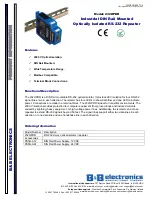
Note: Heater will not operate without socket cover or thermostat.
5.3 Heat Ducting
There are a few things to keep in mind when ducting a heater.
First, ensure that the duct is rated high enough for the heater’s
discharge temperature. Second, make sure that the duct I.D. is
equal to the diameter of the heater discharge. A larger I.D.
solid wall or wire duct (no lay-flat) duct can be used. When
dealing with duct length, remember that the owner’s manual
will list a MAXIMUM duct length and this length must be
adhered to at all times! The maximum duct length is the total
length straight out from the nose of the heater. As a general
rule of thumb, for every bend in the duct, it cuts the maximum
length allowed in half. Also, to achieve the highest heating effi-
ciency and to alleviate static pressure issues, keep the elbows
and bends down to the absolute minimum.
5.4 Shut Down.
Set switch to “OFF” to shut the flame off. The fan
will go on rotating for about 1 min 45 sec to cool
the heater down. The fan motor will automatically
stop at the end of the aftercooling time, then the
unit can be disconnected from mains.
Never disconnect the supply plug to stop the
heater while in operation. The heat accumulation
could damage the components: allow the cooling
sequence to be carried out.
5.5 Outdoor use
If the heater is used outdoors, follow the general
installation instructions detailed above (see point
4). Moreover, the heater should not be directly
exposed to the weather. Provide proper protec-
tion from rain, snow, wind, humidity etc. the use
of a vent cap is also required.
Go to page 18 for proper
chimney/exhaust pipe
installation.
7
grounded
duct restriction
before using the heater again. Have the
heater inspected by a qualified technician
if required. See point above for resetting.
)
Summary of Contents for HVF180
Page 4: ...4 TECHNICIAN ...
Page 5: ... CFM 5 6 ft ...
Page 18: ...Chimney Exhaust Set Up 18 9 ft 30 ft 15 ft 3 ft 12 ft ...





































